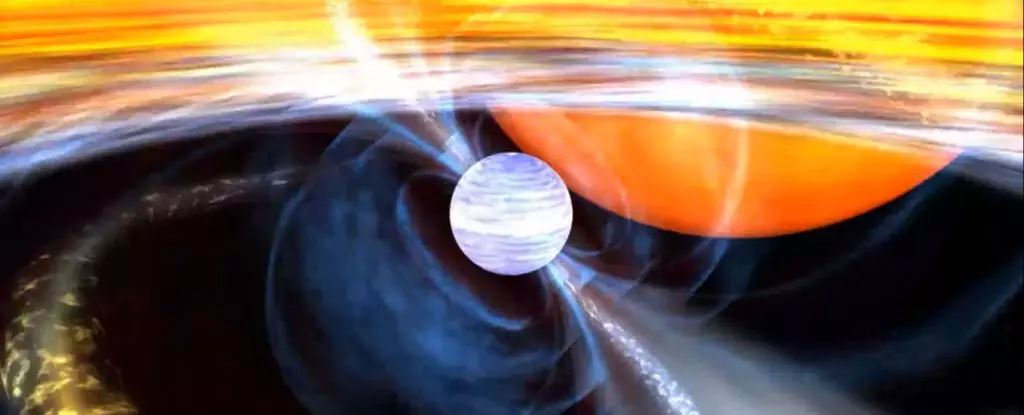Astrophysics tirelessly delves into the mysteries of the cosmos, peeling back layers to reveal the breathtaking wonders of celestial bodies. Among these peculiar entities lies the neutron star 4U 1820-30, located approximately 27,400 light-years from Earth, exhilarating astronomers with its astonishing performance in a binary stellar dance. The recent research conducted by a team spearheaded by Gaurava Jaisawal at the Technical University of Denmark has brought to light unprecedented observations of this elusive celestial body, urging a deeper understanding of neutron stars and their extreme characteristics.
In the heart of the binary system 4U 1820-30, a neutron star captivates attention by rapidly spinning with an overwhelming velocity of 716 rotations per second. This astonishing speed positions it at the zenith of known neutron star rotation, teetering on the brink of the theoretical maximum believed to be around 730 rotations per second. This discovery holds significant implications, with the first indications suggesting that pulsar PSR J1748-2446ad, known for its extraordinary rotation speed as a radio pulsar, might soon have a contender for the title of the fastest-spinning star under thermonuclear criteria.
Jaisawal emphasized the importance of this research, stating, “We were initially investigating thermonuclear explosions associated with this binary system, but the unexpected oscillations revealed a mesmerizing phenomenon.” If further observations substantiate these findings, 4U 1820-30 may indeed claim its place among the universe’s most rapid celestial objects.
Neutron stars serve as a compelling narrative in the life cycle of massive stars. The evolutionary journey begins with stars that possess a mass approximately 8 to 30 times greater than that of our Sun. Upon exhausting the nuclear fuel in its core, the star undergoes a spectacular supernova explosion, expelling its outer layers while the core collapses under the relentless grip of gravity. This implosion results in a neutron star—an extremely dense entity that packs mass equivalent to 1.1 to 2.3 Suns into an infinitesimally small radius of merely 20 kilometers.
Describing the nature of neutron stars, Sr. Astro-physicist Jerome Chenevez outlined, “Neutron stars manifest extreme phenomena, including pulsars that emit beams of radio waves, akin to cosmic lighthouses, while magnetars possess mind-boggling magnetic fields.” 4U 1820-30 encapsulates a unique character within this classification spectrum.
Discovered in the 1980s, 4U 1820-30 comprises a neutron star and a white dwarf, tightly bound in a complex orbital dance. This orbital connection, completing a cycle every 11.4 minutes, provides an ideal stage for the neutron star to consume its companion star’s material. This ‘cannibalistic’ behavior leads to an accumulation of mass on the neutron star, transforming sheer mass into extraordinarily high temperatures that ultimately trigger thermonuclear explosions.
During these explosions, the neutron star can outshine the Sun by a staggering factor of up to 100,000 times, releasing colossal energy bursts into space. The study conducted from 2017 to 2022 was pivotal in analyzing these enigmatic explosive events, now serving as critical data points in understanding binary star systems and the elemental synthesis within the cosmos.
Upon scrutinizing the data garnered from NASA’s Neutron Star Interior Composition Explorer (NICER), the research team identified an anomalous oscillation signature, recorded at a precise frequency of 716 Hertz during one of the thermonuclear blasts. This remarkable finding implies a unique rotation of the neutron star concurrent with the explosion. If confirmed, this transformative insight positions 4U 1820-30 as potentially the fastest-known nuclear-powered pulsar, a distinction that could reshape the understanding of neutron stars.
While conclusions need to be prudently verified, the promising data suggests that the observations will pave new pathways for investigating the extremes of neutron star behaviors and the potential for self-destructive phenomenons. The quest to study and understand the disparate features of neutron stars continues, and 4U 1820-30 stands as a luminous example illuminating the vast expanse of our universe.
The binary system of 4U 1820-30 not only fascinates with its rapid pulsations and exquisite behaviors but also ignites inquiries into the fundamental life cycles of the stars. As scientific observation and research progress, the universe unveils its wonders one pulsar at a time, allowing humankind glimpses into untold passions of the cosmos.


Leave a Reply